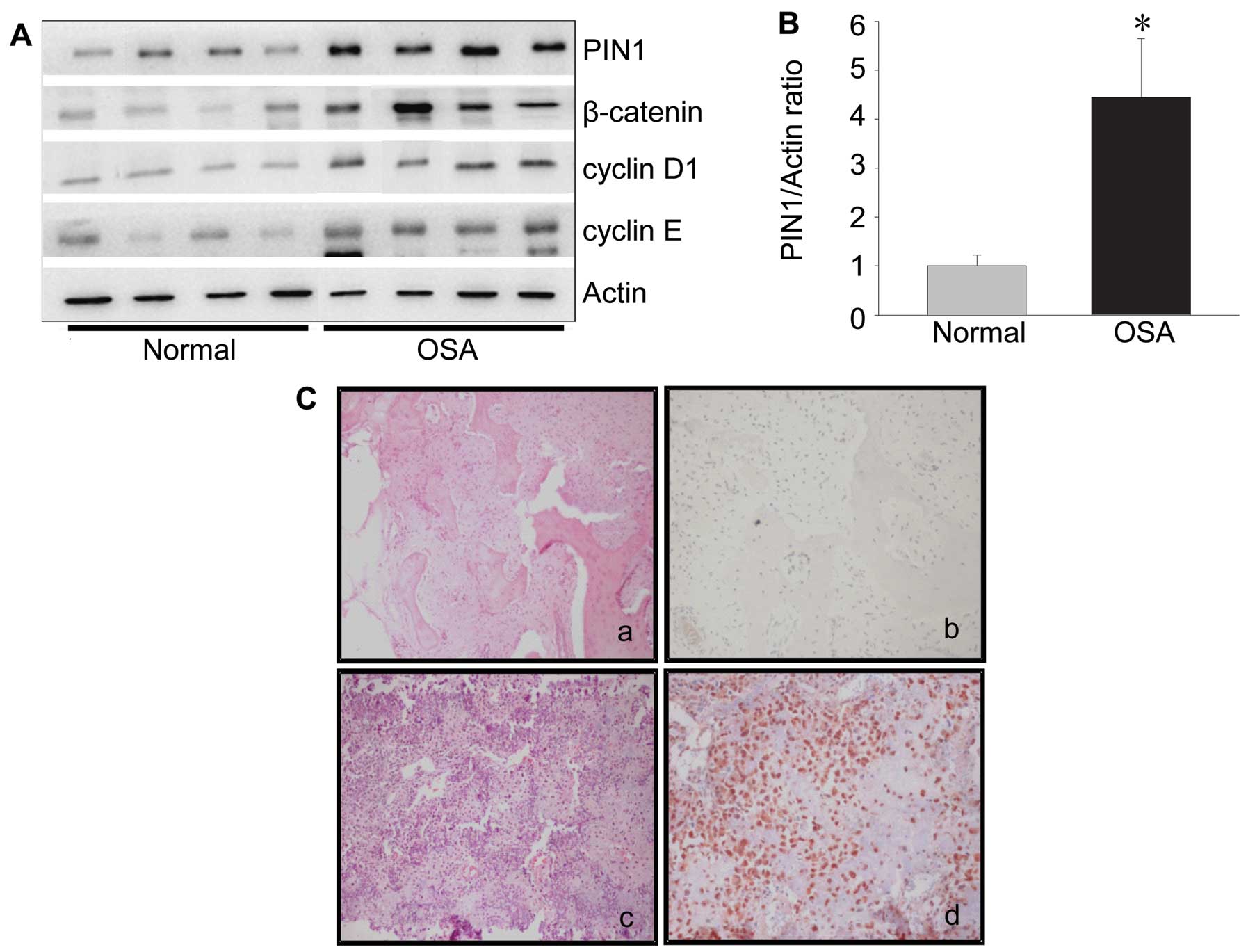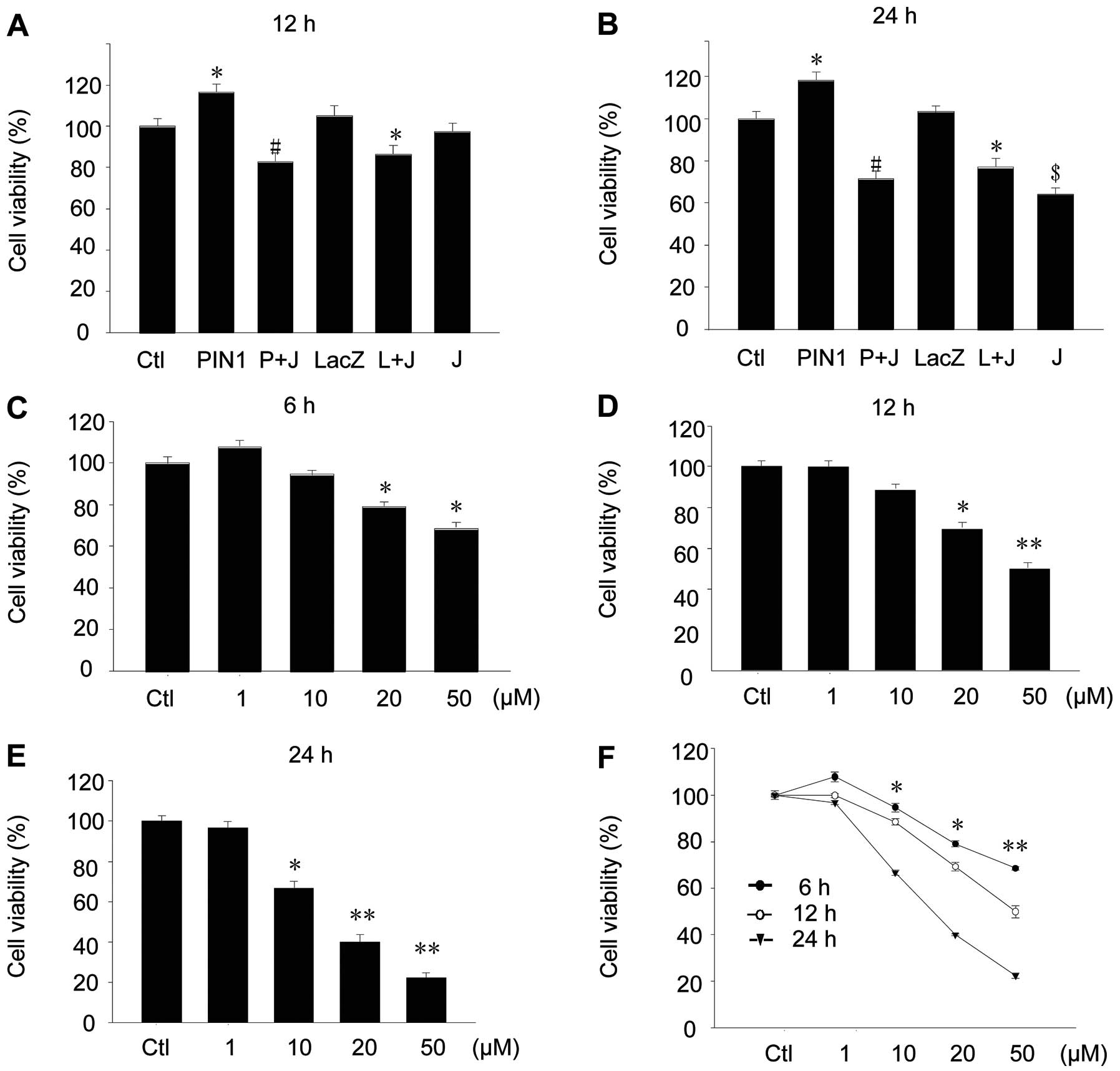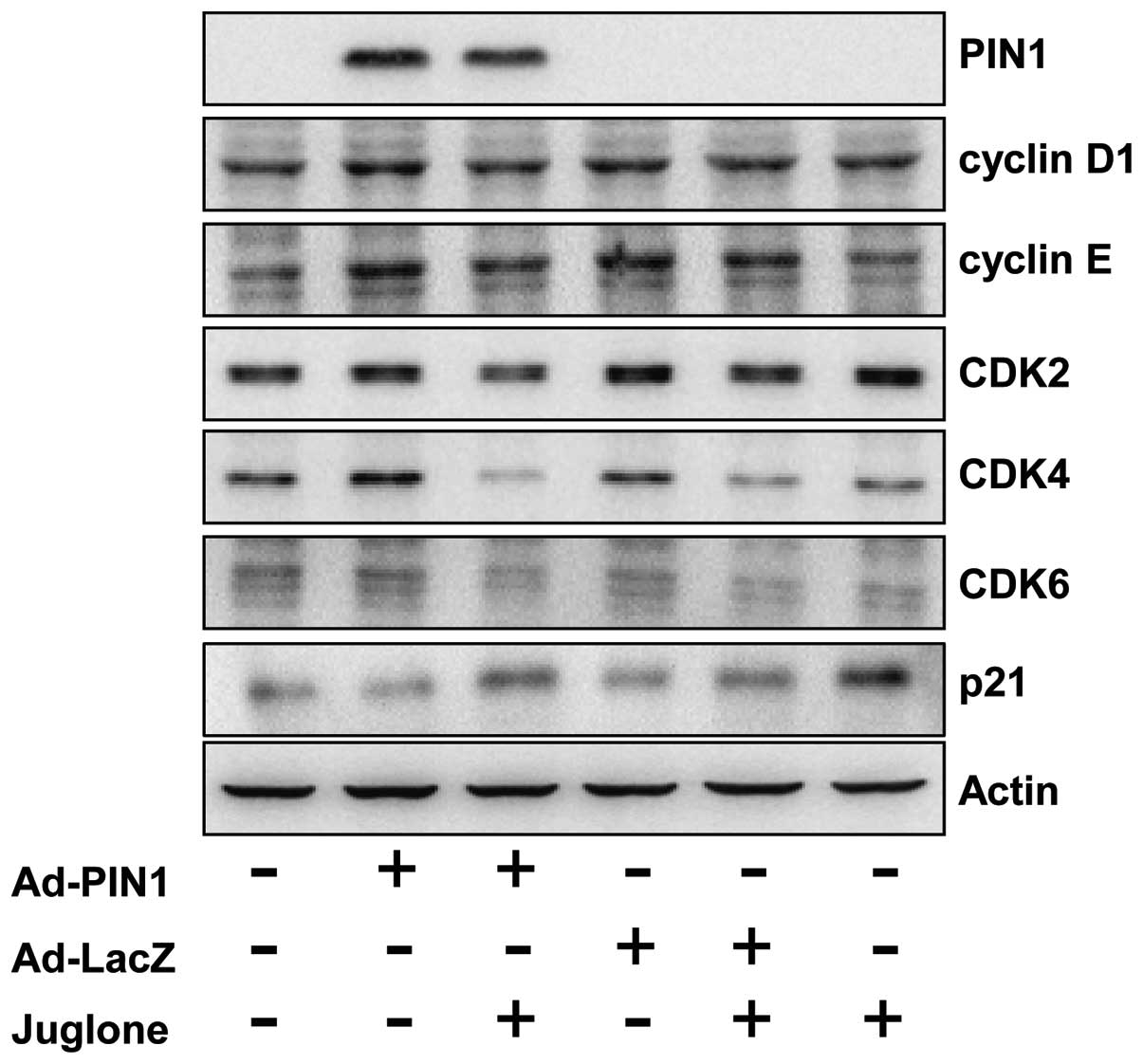|
1
|
Galat A: Peptidylprolyl cis/trans
isomerases (immunophilins): biological diversity - targets -
functions. Curr Top Med Chem. 3:1315–1347. 2003. View Article : Google Scholar : PubMed/NCBI
|
|
2
|
Lu KP, Suizu F, Zhou XZ, Finn G, Lam P and
Wulf G: Targeting carcinogenesis: a role for the prolyl isomerase
Pin1? Mol Carcinog. 45:397–402. 2006. View
Article : Google Scholar : PubMed/NCBI
|
|
3
|
Lu KP, Hanes SD and Hunter T: A human
peptidyl-prolyl isomerase essential for regulation of mitosis.
Nature. 380:544–547. 1996. View
Article : Google Scholar : PubMed/NCBI
|
|
4
|
Blume-Jensen P and Hunter T: Oncogenic
kinase signalling. Nature. 411:355–365. 2001. View Article : Google Scholar : PubMed/NCBI
|
|
5
|
Hunter T: Prolyl isomerases and nuclear
function. Cell. 92:141–143. 1998. View Article : Google Scholar : PubMed/NCBI
|
|
6
|
Berger M, Stahl N, Del Sal G and Haupt Y:
Mutations in proline 82 of p53 impair its activation by Pin1 and
Chk2 in response to DNA damage. Mol Cell Biol. 25:5380–5388. 2005.
View Article : Google Scholar : PubMed/NCBI
|
|
7
|
Albert A, Lavoie S and Vincent M: A
hyperphosphorylated form of RNA polymerase II is the major
interphase antigen of the phosphoprotein antibody MPM-2 and
interacts with the peptidyl-prolyl isomerase Pin1. J Cell Sci.
112:2493–2500. 1999.PubMed/NCBI
|
|
8
|
Liou YC, Ryo A, Huang HK, et al: Loss of
Pin1 function in the mouse causes phenotypes resembling cyclin
D1-null phenotypes. Proc Natl Acad Sci USA. 99:1335–1340. 2002.
View Article : Google Scholar : PubMed/NCBI
|
|
9
|
Ryo A, Nakamura M, Wulf G, Liou YC and Lu
KP: Pin1 regulates turnover and subcellular localization of
beta-catenin by inhibiting its interaction with APC. Nat Cell Biol.
3:793–801. 2001. View Article : Google Scholar : PubMed/NCBI
|
|
10
|
Yaffe MB, Schutkowski M, Shen M, et al:
Sequence-specific and phosphorylation-dependent proline
isomerization: a potential mitotic regulatory mechanism. Science.
278:1957–1960. 1997. View Article : Google Scholar
|
|
11
|
Zhou XZ, Kops O, Werner A, et al:
Pin1-dependent prolyl isomerization regulates dephosphorylation of
Cdc25C and tau proteins. Mol Cell. 6:873–883. 2000. View Article : Google Scholar : PubMed/NCBI
|
|
12
|
Fujimori F, Takahashi K, Uchida C and
Uchida T: Mice lacking Pin1 develop normally, but are defective in
entering cell cycle from G(0) arrest. Biochem Biophys Res Commun.
265:658–663. 1999. View Article : Google Scholar : PubMed/NCBI
|
|
13
|
Maleszka R, Hanes SD, Hackett RL, de Couet
HG and Miklos GL: The Drosophila melanogaster dodo (dod)
gene, conserved in humans, is functionally interchangeable with the
ESS1 cell division gene of Saccharomyces cerevisiae. Proc
Natl Acad Sci USA. 93:447–451. 1996.
|
|
14
|
Hsu T, McRackan D, Vincent TS and Gert de
Couet H: Drosophila Pin1 prolyl isomerase Dodo is a MAP
kinase signal responder during oogenesis. Nat Cell Biol. 3:538–543.
2001. View
Article : Google Scholar
|
|
15
|
Wulf GM, Ryo A, Wulf GG, et al: Pin1 is
overexpressed in breast cancer and cooperates with Ras signaling in
increasing the transcriptional activity of c-Jun towards cyclin D1.
EMBO J. 20:3459–3472. 2001. View Article : Google Scholar : PubMed/NCBI
|
|
16
|
Miyashita H, Uchida T, Mori S, Echigo S
and Motegi K: Expression status of Pin1 and cyclins in oral
squamous cell carcinoma: Pin1 correlates with cyclin D1 mRNA
expression and clinical significance of cyclins. Oncol Rep.
10:1045–1048. 2003.PubMed/NCBI
|
|
17
|
Lee JH, Song MY, Song EK, et al:
Overexpression of SIRT1 protects pancreatic beta-cells against
cytokine toxicity by suppressing the nuclear factor-kappaB
signaling pathway. Diabetes. 58:344–351. 2009. View Article : Google Scholar : PubMed/NCBI
|
|
18
|
Ayala G, Wang D, Wulf G, et al: The prolyl
isomerase Pin1 is a novel prognostic marker in human prostate
cancer. Cancer Res. 63:6244–6251. 2003.PubMed/NCBI
|
|
19
|
Bao L, Kimzey A, Sauter G, Sowadski JM, Lu
KP and Wang DG: Prevalent overexpression of prolyl isomerase Pin1
in human cancers. Am J Pathol. 164:1727–1737. 2004. View Article : Google Scholar : PubMed/NCBI
|
|
20
|
Chen SY, Wulf G, Zhou XZ, Rubin MA, Lu KP
and Balk SP: Activation of beta-catenin signaling in prostate
cancer by peptidyl-prolyl isomerase Pin1-mediated abrogation of the
androgen receptor-beta-catenin interaction. Mol Cell Biol.
26:929–939. 2006. View Article : Google Scholar : PubMed/NCBI
|
|
21
|
Fukuchi M, Fukai Y, Kimura H, et al:
Prolyl isomerase Pin1 expression predicts prognosis in patients
with esophageal squamous cell carcinoma and correlates with cyclin
D1 expression. Int J Oncol. 29:329–334. 2006.PubMed/NCBI
|
|
22
|
Kim CJ, Cho YG, Park YG, et al: Pin1
overexpression in colorectal cancer and its correlation with
aberrant beta-catenin expression. World J Gastroenterol.
11:5006–5009. 2005.PubMed/NCBI
|
|
23
|
Kokkinakis DM, Liu X and Neuner RD:
Modulation of cell cycle and gene expression in pancreatic tumor
cell lines by methionine deprivation (methionine stress):
implications to the therapy of pancreatic adenocarcinoma. Mol
Cancer Ther. 4:1338–1348. 2005. View Article : Google Scholar
|
|
24
|
Kuramochi J, Arai T, Ikeda S, Kumagai J,
Uetake H and Sugihara K: High Pin1 expression is associated with
tumor progression in colorectal cancer. J Surg Oncol. 94:155–160.
2006. View Article : Google Scholar : PubMed/NCBI
|
|
25
|
He J, Zhou F, Shao K, et al:
Overexpression of Pin1 in non-small cell lung cancer (NSCLC) and
its correlation with lymph node metastases. Lung Cancer. 56:51–58.
2007. View Article : Google Scholar : PubMed/NCBI
|
|
26
|
Clurman BE and Roberts JM: Cell cycle and
cancer. J Natl Cancer Inst. 87:1499–1501. 1995. View Article : Google Scholar : PubMed/NCBI
|
|
27
|
Sherr CJ: Cancer cell cycles. Science.
274:1672–1677. 1996. View Article : Google Scholar : PubMed/NCBI
|
|
28
|
Jacks T and Weinberg RA: Cell-cycle
control and its watchman. Nature. 381:643–644. 1996. View Article : Google Scholar : PubMed/NCBI
|
|
29
|
Pestell RG, Albanese C, Reutens AT, Segall
JE, Lee RJ and Arnold A: The cyclins and cyclin-dependent kinase
inhibitors in hormonal regulation of proliferation and
differentiation. Endocr Rev. 20:501–534. 1999.PubMed/NCBI
|
|
30
|
Yeh ES, Lew BO and Means AR: The loss of
PIN1 deregulates cyclin E and sensitizes mouse embryo fibroblasts
to genomic instability. J Biol Chem. 281:241–251. 2006. View Article : Google Scholar : PubMed/NCBI
|
|
31
|
Yeh E, Cunningham M, Arnold H, et al: A
signalling pathway controlling c-Myc degradation that impacts
oncogenic transformation of human cells. Nat Cell Biol. 6:308–318.
2004. View
Article : Google Scholar : PubMed/NCBI
|
|
32
|
Xiong Y, Hannon GJ, Zhang H, Casso D,
Kobayashi R and Beach D: p21 is a universal inhibitor of cyclin
kinases. Nature. 366:701–704. 1993. View
Article : Google Scholar : PubMed/NCBI
|
|
33
|
Kim MR, Choi HK, Cho KB, Kim HS and Kang
KW: Involvement of Pin1 induction in epithelial-mesenchymal
transition of tamoxifen-resistant breast cancer cells. Cancer Sci.
100:1834–1841. 2009. View Article : Google Scholar : PubMed/NCBI
|


















